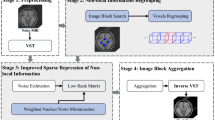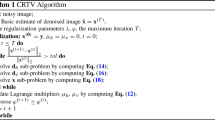Abstract
The low-rank matrix approximation (LRMA) is an efficient image denoising method to reduce additive Gaussian noise. However, the existing low-rank matrix approximation does not perform well in terms of Rician noise removal for magnetic resonance imaging (MRI). To this end, we propose a novel MR image denoising approach based on the extended difference of Gaussian (DoG) filter and nonlocal low-rank regularization. In the proposed method, a novel nonlocal self-similarity evaluation with the tight frame is exploited to improve the patch matching. To remove the Rician noise and preserve the edge details, the extended DoG filter is exploited to the nonlocal low-rank regularization model. The experimental results demonstrate that the proposed method can preserve more edge and fine structures while removing noise in MR image as compared with some of the existing methods.









Similar content being viewed by others
References
Manjón JV, Coupé P, Buades A (2015) MRI noise estimation and denoising using non-local PCA. Med Image Anal 22(1):35–47
Birch P, Mitra B, Bangalore NM, Rehman S, Young R, Chatwin C (2010) Approximate bandpass and frequency response models of the difference of gaussian filter. Opt Commun 283(24):4942–4948
Cai JF, Cand EJS, Shen Z (2008) A singular value thresholding algorithm for matrix completion. SIAM J Optim 20(4):1956–1982
Cai JF, Ji H, Shen Z, Ye GB (2014) Data-driven tight frame construction and image denoising. Appl Comput Harmon Anal 37(1):89–105
Candes EJ, Plan Y (2009) Matrix completion with noise. Proc IEEE 98(6):925–936
Chen L, Zeng T (2015) A convex variational model for restoring blurred images with large rician noise. J Math Imaging Vis 53(1):92–111
Chen Z, Fu Y, Xiang Y, Rong R (2017) A novel iterative shrinkage algorithm for CS-MRI via adaptive regularization. IEEE Signal Process Lett 24(10):1443–1447
Chen Z, Fu Y, Xiang Y, Xu J, Rong R (2018) A novel low-rank model for MRI using the redundant wavelet tight frame. Neurocomputing 289:180–187
Chen Z, Huang C, Lin S (2020) A new sparse representation framework for compressed sensing MRI. Knowl-Based Syst 188:104969
Collins DL, Zijdenbos AP, Kollokian V, Sled JG (1998) Design and construction of a realistic digital brain phantom. IEEE Trans Med Imaging 17(3):463–468
Coupé P, Manjón JV, Gedamu E, Arnold D, Robles M, Collins LD (2010) Robust rician noise estimation for MR images. Med Image Anal 14(4):483–493
Coupe P, Yger P, Prima S, Hellier P, Kervrann C, Barillot C (2008) An optimized blockwise nonlocal means denoising filter for 3-D magnetic resonance images. IEEE Trans Med Imaging 27(4):425–441
Dai S, Han M, Ying W u, Gong Y (2007) Bilateral back-projection for single image super resolution. In: IEEE International conference on multimedia and expo, pp 1039–1042
Dong W, Lei Z, Shi G, Xin L (2013) Nonlocally centralized sparse representation for image restoration. IEEE Trans Image Process 22(4):1620–1630
Dong W, Shi G, Li X, Peng K, Wu J, Guo Z (2016) Color-guided depth recovery via joint local structural and nonlocal low-rank regularization. IEEE Trans Multimed 19(2):293–301
Foi A (2011) Noise estimation and removal in MR imaging: The variance-stabilization approach. In: IEEE International symposium on biomedical imaging: from Nano to macro, pp 1809–1814
Ge Q, Jing XY, Wu F, Wei Z, Xiao L, Shao W, Yue D, Li H (2016) Structure-based low-rank model with graph nuclear norm regularization for noise removal. IEEE Trans Image Process 26(7):3098–3112
Getreuer P, Tong M, Vese LA (2011) A variational model for the restoration of MR images corrupted by blur and rician noise. In: Advances in visual computing, pp 686–698
Golshan HM, Hasanzadeh RP, Yousefzadeh SC (2013) An MRI denoising method using image data redundancy and local SNR estimation. Magn Reson Imaging 31(7):1206–1217
Shuhang G u, Qi X, Meng D, Zuo W, Feng X, Zhang L (2017) Weighted nuclear norm minimization and its applications to low level vision. Int J Comput Vis 121(2):183–208
He L, Greenshields IR (2009) A nonlocal maximum likelihood estimation method for rician noise reduction in MR images. IEEE Trans Med Imaging 28(2):165–172
Huang Yu-Mei, Yan Hui-Yin, Wen You-Wei, Yang X (2018) Rank minimization with applications to image noise removal. Inform Sci 429:147–163
Jia X, Feng X, Wang W (2016) Rank constrained nuclear norm minimization with application to image denoising. Signal Process 129:1–11
Jiang M, Han L, Wang Y, Lu Y, Shentu N (2015) G Qiu. 3-D total generalized variation method for dynamic cardiac MR image denoising. J Fiber Bioeng Inform 8(3):557–564
Jianjun Y (2018) An improved variational model for denoising magnetic resonance images. Comput Math with Appl 76:2212–2222
Lai Z, Chen Z, Ye J, Di G, Xiaobo Q u, Liu Y, Zhan Z (2016) Image reconstruction of compressed sensing MRI using graph-based redundant wavelet transform. Med Image Anal 27:93– 104
Lecun Y, Bengio Y, Hinton G (2015) Deep learning. Nature 521:436–444
Li S, Yin H, Fang L (2012) Group-sparse representation with dictionary learning for medical image denoising and fusion. IEEE Trans Biomed Eng 59(12):3450–3459
Liu L u, Yang H, Fan J, Liu RW, Duan Y (2019) Rician noise and intensity nonuniformity correction (NNC) model for MRI data. Biomed Signal Process Control 49:506–519
Liu RW, Shi L, Huang W, Xu J, Yu SCH, Wang D (2014) Generalized total variation-based MRI rician denoising model with spatially adaptive regularization parameters. Magn Reson Imaging 32(6):702–720
Liu RW, Shi L, Huang W, Jing X u, Simon Chun Ho Y u, Wang D (2014) Generalized total variation-based mri rician denoising model with spatially adaptive regularization parameters. Magn Reson Imaging 32(6):702–720
Liu X, Jing XY, Tang G, Fei W u, Qi G e (2017) Image denoising using weighted nuclear norm minimization with multiple strategies. Signal Process 135(C):239–252
Elad M, Aharon M (2006) Image denoising via sparse and redundant representations over learned dictionaries. IEEE Trans Image Process 15(12):3736–3745
Macovski A (1996) Noise in MRI. Magn Reson Med 36(3):494–497
Maggioni M, Katkovnik V, Egiazarian K, Foi A (2013) Nonlocal transform-domain filter for volumetric data denoising and reconstruction. IEEE Trans Image Process 22(1):119–133
Manjón JV, Carbonellcaballero J, Lull JJ, Garcíamartí G, Martíbonmatí L, Robles M (2008) MRI denoising using non-local means. Med Image Anal 12(4):514–523
Manjn JV, Coup P, Buades A, Louis CD, Robles M (2012) New methods for MRI denoising based on sparseness and self-similarity. Med Image Anal 16(1):18–27
Miller AJ, Joseph PM (1993) The use of power images to perform quantitative analysis on low SNR MR images. Magn Reson Imaging 11(7):1051–1056
Qu X, Hou Y, Lam F, Guo D, Zhong J, Chen Z (2014) Magnetic resonance image reconstruction from undersampled measurements using a patch-based nonlocal operator. Med Image Anal 18(6):843–856
Qu X, Zhang W, Di G, Cai C, Cai S, Chen Z (2010) Iterative thresholding compressed sensing mri based on contourlet transform. Inverse Probl Sci Eng 18(6):737–758
Shen L, Papadakis M, Kakadiaris I, Konstantinidis I, Kouri D, Hoffman D (2006) Image denoising using a tight frame. IEEE Trans Image Process 15(5):1254–1263
Tan Y, Hou X, Chen Z, Yu S (2017) Image compressive sensing reconstruction based on collaboration reduced rank preprocessing. Electron Lett 53(11):717–718
Wang Q, Zhang X, Wu Y, Tang L, Zha Z (2017) Non-convex weighted ℓp minimization based group sparse representation framework for image denoising. IEEE Signal Process Lett 24 (11):1686–1690
Wang S, Zhang L, Liang Y (2012) Nonlocal spectral prior model for low-level vision, pp 231–244
Wang Z, Bovik AC (2002) A universal image quality index. IEEE Signal Process Lett 9 (3):81–84
Winnemöller H, Kyprianidis JE, Olsen SC (2012) Xdog: An extended difference-of-gaussians compendium including advanced image stylization. Comput Graph 36(6):740–753
Yi X, Gao Q, Cheng N, Lu Y, Zhang D, Ye Q (2017) Denoising 3-D magnitude magnetic resonance images based on weighted nuclear norm minimization. Biomed Signal Process Control 34:183–194
Xiong R, Liu H, Zhang X, Zhang J, Ma S, Wu F, Gao W (2016) Image denoising via bandwise adaptive modeling and regularization exploiting nonlocal similarity. IEEE Trans Image Process 25 (12):5793–5805
Yi X, Gao Q, Nan C, Lu Y, Zhang D, Ye Q (2017) Denoising 3-D magnitude magnetic resonance images based on weighted nuclear norm minimization. Biomed Signal Process Control 34:183–194
Zhai L, Fu S, Lv H, Zhang C, Wang F (2018) Weighted schatten p-norm minimization for 3D magnetic resonance images denoising. Brain Res Bull 142:270–280
Author information
Authors and Affiliations
Corresponding author
Additional information
Publisher’s note
Springer Nature remains neutral with regard to jurisdictional claims in published maps and institutional affiliations.
Appendix:
Appendix:
By the sparse representation of tight frame \(\textit {\textbf {D}}_{l}^{H}\textit {\textbf {D}}_{l}=\boldsymbol {I}\), let \(\boldsymbol {L}_{\textbf {Z}_{l}}\) and \(\boldsymbol {L}_{\textbf {S}_{l}}\) be the transform domain representation of Zl and Sl, respectively, i.e., \(\boldsymbol {L}_{\textbf {Z}_{l}}=\textit {\textbf {D}}_{l}\textbf {Z}_{l}\), \(\boldsymbol {L}_{\textbf {S}_{l}}=\textit {\textbf {D}}_{l}\textbf {S}_{l}\). Then, the minimization problem of Eq. 12 can be given by:
where (a) is from the tight frame and
Let the SVD of \(\boldsymbol {L}_{\textbf {Z}_{l}}\) be \(\boldsymbol {L}_{\textbf {Z}_{l}}=\textbf {U}_{l}\boldsymbol {\varSigma }_{\textbf {Z}_{l}}\textbf {V}_{l}^{H}\) and define the matrix \(\boldsymbol {\varPhi }_{l}\triangleq \textbf {U}_{l}^{H}\boldsymbol {L}_{\textbf {S}_{l}}\textbf {V}_{l}\), then the objective function in Eq. 33 can be rewritten as:
where (a) is from the SVD of the Φl that \(\boldsymbol {\varPhi }_{l}=\textbf {U}_{\boldsymbol {\varPhi }_{l}}\boldsymbol {\varSigma }_{\boldsymbol {\varPhi }_{l}}\textbf {V}_{\boldsymbol {\varPhi }_{l}}^{T}\) and (b) follows from the fact that
and σi(⋅) denotes the i-th largest singular value of a matrix.
Equation 35 holds if and only if \(\boldsymbol {\varPhi }_{l}=\boldsymbol {\varSigma }_{\boldsymbol {\varPhi }_{l}}\). Therefore, the rank minimization problem (33) is equivalent to the following minimization:
where \(\boldsymbol {W}_{l}=\text {diag}\{w_{l_{1}},w_{l_{2}},...,w_{l_{r}}\}\) is a diagonal matrix.
Next, we will prove the minimization \(\frac {1}{2}\|\boldsymbol {\varSigma }_{_{\textbf {Z}_{l}}}-\boldsymbol {\varSigma }_{\boldsymbol {\varPhi }_{l}}\|_{F}^{2}+\|\boldsymbol {W}_{l}\boldsymbol {\varSigma }_{\boldsymbol {\varPhi }_{l}}\|_{*}\) in Eq. 36 is equivalent to
By the property of matrix norm, we have:
Then, it easily follows that
On the other hand,
It follows that
Suppose Ω1 and Ω2 are the solutions of the optimization problems (36) and (37), respectively. By Eq. 39, \(\forall {\boldsymbol {\varSigma }^{\prime }}_{\boldsymbol {\varPhi }_{l}}\in {\varOmega }_{1}\), for any \(\boldsymbol {\varSigma }_{\boldsymbol {\varPhi }_{l}}\in {\varOmega }_{2}\), the following relationship can be easily obtained:
which implies that \({\varOmega }_{2}\subseteq {\varOmega }_{1}\).
According to Eq. 41, \(\forall \boldsymbol {\varSigma }_{\boldsymbol {\varPhi }_{l}}\in {\varOmega }_{2}\), for any \({\boldsymbol {\varSigma }^{\prime }}_{\boldsymbol {\varPhi }_{l}}\in {\varOmega }_{1}\), we can derive:
From the above result, we have \({\varOmega }_{1}\subseteq {\varOmega }_{2}\). Furthermore, we easily obtain Ω2 = Ω1 which implies that the optimization problem (33) is equivalent to the minimization (37).
It completes the proof.
Rights and permissions
About this article
Cite this article
Chen, Z., Zhou, Z. & Adnan, S. Joint low-rank prior and difference of Gaussian filter for magnetic resonance image denoising. Med Biol Eng Comput 59, 607–620 (2021). https://doi.org/10.1007/s11517-020-02312-8
Received:
Accepted:
Published:
Issue Date:
DOI: https://doi.org/10.1007/s11517-020-02312-8




